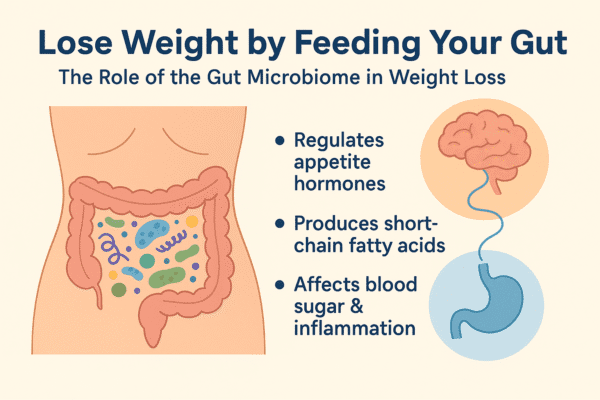Can you really lose weight by eating more—as long as you’re feeding your gut microbes? According to the latest trend sweeping through wellness communities in the U.S., the answer is yes.
From celebrity nutritionists to Harvard researchers, everyone is talking about the gut microbiome—the trillions of bacteria living in your digestive system—and its surprising role in metabolism and fat loss. Welcome to the new frontier in weight loss: “gut-first dieting.”
What Is the Gut Microbiome, and Why Does It Matter for Weight Loss?
Your gut is home to an ecosystem of bacteria, fungi, and other microorganisms. Collectively, this community is called your gut microbiome, and it affects much more than just digestion:

- It helps regulate appetite hormones like ghrelin and leptin
- It produces short-chain fatty acids (SCFAs) that influence fat storage
- It affects blood sugar control, inflammation, and energy levels
- It even communicates with your brain via the gut-brain axis
Research now suggests that an imbalanced microbiome (dysbiosis) may contribute to weight gain, cravings, insulin resistance, and even depression.
How Americans Are Losing Weight by Feeding Their Gut
Rather than focusing only on calories, the microbiome approach is about feeding the right bacteria. Popular methods include:

1. Prebiotic-Rich Foods
Foods high in fermentable fiber that feed beneficial bacteria:
- Chicory root, garlic, leeks, onions, green bananas, oats
2. Fermented Foods
These add new healthy microbes to your gut:
- Kimchi, kefir, sauerkraut, yogurt with live cultures, miso, tempeh
3. Polyphenol-Rich Plants
Colorful fruits and vegetables that feed diverse bacteria:
- Berries, red cabbage, spinach, olive oil, dark chocolate
4. Limiting Ultra-Processed Foods
Which can kill beneficial bacteria and encourage inflammation-promoting species.
5. Taking Precision Probiotics
Some new products claim to target weight management by altering your gut flora—but results vary and are still being studied.
The “Gut Health Diet” Trend in the U.S.
The microbiome weight loss trend is gaining momentum thanks to:
- Popular books like “Fiber Fueled” and “The Gut-Immune Connection”
- TikTok and YouTube creators promoting gut-healing meal plans
- U.S.-based startups like ZOE (personalized microbiome testing) and Pendulum (targeted probiotics for metabolism)
It’s become common for Americans to track not just macros—but microbiome scores through stool testing.
Does It Really Work? The Science So Far
- A 2020 study from the Weizmann Institute showed individual microbiome types predict weight loss success.
- Higher microbial diversity is linked to better metabolic health.
- Some trials show that prebiotic fibers (like inulin) can support fat loss and appetite regulation.
However, results vary between individuals, and gut healing is a long-term process—not a quick fix.
What to Watch Out For
- Not all probiotics work for everyone—and many are overpriced or under-dosed.
- People with IBS or SIBO may react poorly to too much fiber or fermentation.
- Microbiome-based dieting is still a growing field, and not all claims are backed by large-scale studies.
Gut-Friendly Sample Day (for Weight Loss)
| Time | Meal |
| Morning | Overnight oats with chia seeds, berries, and kefir |
| Lunch | Lentil salad with arugula, beets, olive oil, and sauerkraut |
| Snack | Green banana smoothie with flaxseed |
| Dinner | Grilled salmon, quinoa, steamed leeks, and kimchi |
Final Thoughts: Feed Your Gut, Shape Your Body
The microbiome trend is more than just a fad—it’s a paradigm shift. By focusing on what feeds you and your gut bacteria, weight loss becomes less about restriction and more about nourishment, balance, and long-term health.
In a world full of diets that cut, eliminate, or suppress, gut-first eating says: heal, feed, and grow.



